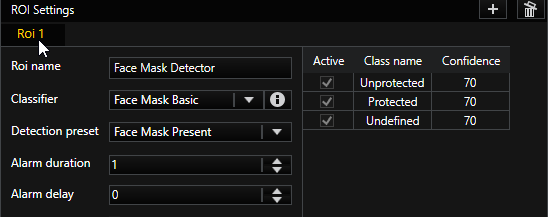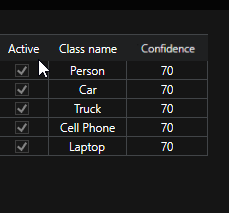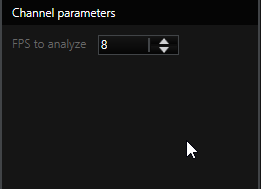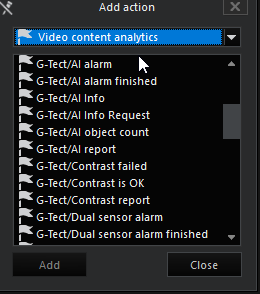AI-Connect
Subject to license
The integration of neural networks is a licensed function for the use of artificial intelligence. The networks used in the G-Tect service have a one- or two-level structure. Single-level networks serve for the "simple" detection of objects within the monitored scenario. Two-level networks are used for detection and classification. This provides a checking logic within the network, which is used to refine and/or verify the results. The aim of the implementation and therefore the great advantage of using neural networks is the application in very specific as well as general areas and scenarios.
With the activation of the basic function via G-Tect/AI-Connect, the user is provided with a general network for the recognition of persons, cars, trucks, mobile phones and notebooks. This is a one-level detector network that searches for the corresponding objects within the image section.
Description of the Configuration Interface
ROI Settings

|
Parameter |
Description |
|---|---|
|
+ Button |
Adds a ROI (=Region of Interest). This region is used for the alarm evaluation and can be adapted to specific requirements with the further setting options. |
|
Roi Name |
Allows to assign a name for the ROI. The name must be unique locally and globally (guid). |
|
Classifier |
Dropdown selection of the available neural network containers. Must be selected separately for each ROI. |
|
Detection preset |
Dropdown selection of the logic selected for the Neural Network. The G-Tect analyses the results according to the selected logic. Must be selected separately for each ROI. |
|
Alarm duration |
The time in seconds that the ROI or corresponding alarm remains in the alarm state and provides visual feedback. Must be selected separately for each ROI. |
|
Alarm delay |
The delay in seconds with which the alarm is triggered (sensitivity is still pending). |
Object Classes
Each net has different object classes. In the case of AI sample NN the selection looks like this:

|
Parameter |
Description |
|---|---|
|
Active |
The check mark determines whether a class is used for further analysis or for alarm forwarding. |
|
Class name |
The name of the object class used for alarm forwarding. |
|
Confidence |
The threshold value is a percentage value that describes the certainty with which an object must be detected in order to be used for further analysis or for alarm forwarding. |
Selection of the threshold value:
During the analysis, each object is checked for its assignment to a class. The assignment is based on the classes of the network. A percentage probability is assigned to each object, which determines to what extent it is the respective class. In the above example, a network could assign a person at detection as follows:
- Person: 95%
- Car: 1%
- Truck: 1%
- Cell Phone: 2%
- Laptop: 1%
→ Total: 100%
The following rules apply to the selection of the threshold value:
The more classes are available within a network, the lower the threshold value must be selected for the analysis. This also applies if only one of the classes is relevant for the analysis.
With increasing similarity of the objects, the possible detection certainty decreases. For this reason, lower threshold values should be selected in such cases.
Channel Parameters

The channel parameter specifies how many images are used for the analysis and thus influences the alarm rate. The default value of 8 FPS should only be changed if objects are moving very fast through the scenario.
Detection List
The detection list supports configuration by displaying detections according to the activated object classes and the logic within the ROI. Thus, alarm messages can already be verified in the G-Set.
Events
To initiate events, an action must be selected from the action list and added to the event list using the Add button:

|
Action |
Description |
|---|---|
|
G-Tect/AI alarm |
Triggers the alarm if the detection matches the activated object classes and the logic within the ROI. Terminates according to the set alarm duration |
|
G-Tect/AI Info |
Not relevant, internally used. |
|
G-Tect/AI Info Request |
Not relevant, internally used. |
|
G-Tect/AI report |
Not relevant, internally used. |
|
G-Tect/AI object count |
Not relevant for configuration, implemented for future development. |
The action is then added and displayed in the setting dialog with the event list on the left-hand edge and the register on the right-hand side of the setting area:
